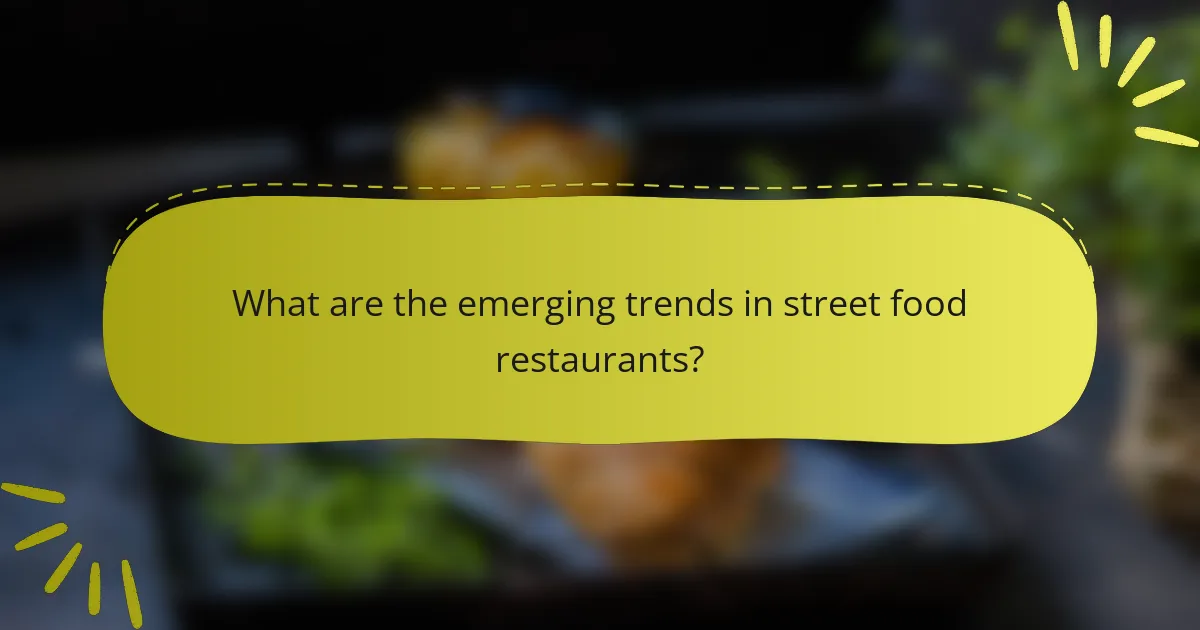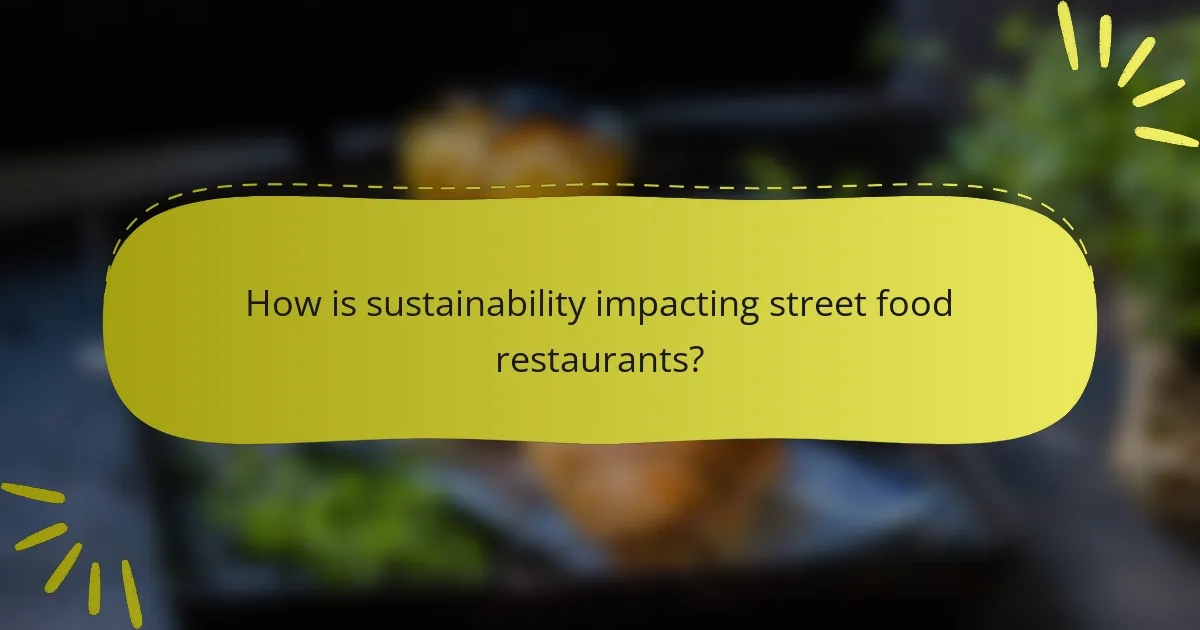The article explores the evolving landscape of street food restaurants, highlighting key trends such as sustainability, culinary fusion, and technology integration. Street food vendors are increasingly prioritizing sustainable ingredients, utilizing locally sourced and organic produce, and adopting eco-friendly practices like biodegradable packaging. The rise of fusion cuisine is evident as vendors creatively blend diverse culinary traditions, attracting a wider customer base with innovative dishes. Additionally, the influence of technology is transforming marketing strategies, with many vendors leveraging social media and online ordering systems. The focus on experiential dining further enhances customer engagement, indicating a dynamic future for street food culture.

What are the emerging trends in street food restaurants?
Emerging trends in street food restaurants include the use of sustainable ingredients and innovative food concepts. Many street food vendors are prioritizing locally sourced and organic produce. This shift reflects a growing consumer demand for healthier and environmentally friendly options.
Additionally, fusion cuisine is gaining popularity. Vendors are creatively combining different culinary traditions to attract diverse customer bases. For instance, Asian-Mexican or Italian-Indian fusion dishes are becoming common.
Plant-based offerings are also on the rise. Many street food restaurants are incorporating vegan and vegetarian options to cater to a broader audience. This aligns with the increasing trend towards plant-based diets.
Technology is influencing street food as well. Many vendors are utilizing social media for marketing and customer engagement. Online ordering and delivery services are becoming standard practices.
Finally, experiential dining is a key trend. Street food restaurants are focusing on creating unique dining experiences. This includes interactive cooking demonstrations and themed food events. These trends indicate a vibrant future for street food culture.
How are consumer preferences shaping the future of street food?
Consumer preferences are significantly shaping the future of street food. Increasing demand for healthier options is prompting vendors to offer more nutritious ingredients. Many consumers are prioritizing sustainability, leading to a rise in eco-friendly packaging and locally sourced foods. There is also a growing interest in diverse culinary experiences, encouraging fusion dishes that blend different cultural flavors. The popularity of food trucks and pop-up stalls is increasing due to their convenience and unique offerings. Additionally, social media influences consumer choices, with visually appealing dishes attracting more customers. According to a report by the National Restaurant Association, 70% of consumers are more likely to choose restaurants that offer sustainable practices. These trends indicate a shift towards more responsible and innovative street food options.
What types of cuisines are gaining popularity in street food?
Asian cuisines, particularly Thai, Korean, and Vietnamese, are gaining popularity in street food. These cuisines offer bold flavors and diverse dishes. Thai street food, known for its balance of sweet, sour, and spicy, includes items like pad Thai and mango sticky rice. Korean street food features dishes such as tteokbokki and Korean fried chicken, appealing to a global audience. Vietnamese street food, including pho and banh mi, is celebrated for its fresh ingredients and vibrant flavors. The rise of food trucks and street vendors has contributed to this trend, making these cuisines more accessible.
How is technology influencing street food offerings?
Technology is significantly influencing street food offerings by enhancing efficiency, variety, and customer engagement. Mobile apps allow vendors to reach wider audiences and streamline orders. Digital payment systems facilitate quick transactions, improving customer satisfaction. Social media platforms help vendors market their offerings and connect with customers. Online reviews and ratings influence consumer choices and vendor reputations. Additionally, food delivery services expand the reach of street food beyond physical locations. These advancements have transformed the street food landscape, making it more accessible and diverse.
Why is street food becoming a cultural phenomenon?
Street food is becoming a cultural phenomenon due to its accessibility, diversity, and social interaction. It offers affordable meals that cater to various tastes and dietary preferences. Street food reflects local culture and traditions, showcasing regional ingredients and cooking methods. The rise of food trucks and pop-up vendors has increased its visibility and popularity. Social media plays a significant role in promoting street food, making it a trendy choice for food enthusiasts. Events and festivals dedicated to street food attract large crowds, further embedding it into popular culture. According to a report by the Food and Agriculture Organization, street food contributes to local economies and provides employment opportunities. This combination of factors drives the cultural significance of street food globally.
What role does social media play in promoting street food?
Social media plays a crucial role in promoting street food by increasing visibility and engagement. Platforms like Instagram and Facebook allow street food vendors to showcase their offerings visually. High-quality images and videos attract potential customers and create buzz around specific dishes. User-generated content, such as customer reviews and photos, enhances credibility and trust. Additionally, social media enables vendors to connect directly with their audience, fostering community and loyalty. According to a study by the Journal of Foodservice Business Research, 70% of consumers are influenced by social media when choosing food options. This demonstrates the significant impact social media has on consumer behavior regarding street food.
How do street food festivals contribute to the trend?
Street food festivals significantly contribute to the trend by popularizing diverse culinary offerings. They showcase a variety of global cuisines in accessible formats. This exposure encourages culinary fusion, blending traditional dishes with modern twists. Festivals also promote sustainability by highlighting local ingredients and reducing food waste. According to the National Restaurant Association, 73% of consumers are more likely to visit restaurants that use locally sourced ingredients. Additionally, street food festivals create community engagement, fostering a sense of belonging and cultural exchange. They attract food enthusiasts, which boosts local economies and supports small vendors. Overall, street food festivals play a crucial role in shaping the future of street food restaurants.

How is sustainability impacting street food restaurants?
Sustainability is significantly impacting street food restaurants by encouraging eco-friendly practices. Many street food vendors are adopting biodegradable packaging to reduce plastic waste. This transition aligns with consumer preferences for environmentally responsible choices. Additionally, sourcing local ingredients supports sustainable agriculture and reduces carbon footprints. A study by the Food and Agriculture Organization indicates that local sourcing can lower transportation emissions by up to 50%. Furthermore, street food restaurants are increasingly implementing waste reduction strategies. These include composting food scraps and recycling materials. Such practices not only enhance their sustainability but also attract eco-conscious customers. Overall, sustainability is reshaping the operational strategies of street food restaurants, making them more environmentally friendly.
What sustainable practices are being adopted by street food vendors?
Street food vendors are adopting various sustainable practices to minimize their environmental impact. Many vendors use biodegradable packaging to reduce plastic waste. They are also sourcing ingredients locally to decrease carbon footprints associated with transportation. Some vendors implement waste segregation systems to promote recycling and composting. Additionally, many are utilizing energy-efficient cooking methods to conserve resources. A report by the Food and Agriculture Organization highlights that sustainable sourcing can enhance food security while supporting local economies. These practices reflect a growing trend among street food vendors to align with sustainability goals.
How does sourcing local ingredients benefit street food businesses?
Sourcing local ingredients benefits street food businesses by enhancing freshness and flavor. Local ingredients are often harvested at peak ripeness, which improves taste. This can lead to higher customer satisfaction and repeat business. Additionally, using local produce supports regional economies and reduces transportation costs. This can increase profit margins for street food vendors. Studies show that consumers prefer locally sourced food, which can boost sales. Furthermore, local sourcing can create unique menu items that reflect regional culture. This differentiation helps street food businesses stand out in a competitive market.
What are the environmental impacts of street food waste management?
Street food waste management significantly impacts the environment. Proper waste management reduces pollution from organic waste. It minimizes greenhouse gas emissions, which contribute to climate change. Effective recycling and composting can turn waste into useful products. This process conserves natural resources and reduces landfill use. Furthermore, it promotes sustainable practices within communities. Studies show that cities with efficient street food waste management see improved urban cleanliness. This enhances public health and the overall quality of life.
Why is sustainability important for the future of street food?
Sustainability is crucial for the future of street food because it addresses environmental concerns. Street food vendors often rely on local ingredients, reducing transportation emissions. Sustainable practices can enhance food safety and quality. According to a study by the Food and Agriculture Organization, sustainable food systems can reduce waste by up to 50%. Additionally, consumers increasingly prefer eco-friendly options. This demand can drive street food vendors to adopt sustainable practices. Ultimately, sustainability can lead to economic benefits for vendors through increased customer loyalty.
How can street food restaurants educate consumers about sustainability?
Street food restaurants can educate consumers about sustainability by promoting eco-friendly practices. They can provide information on sourcing local ingredients to reduce carbon footprints. Many street food vendors can showcase compostable packaging to minimize waste. They can also offer workshops on sustainable cooking methods. Engaging customers in discussions about food waste can raise awareness. Sharing tips on recycling and composting can further enhance consumer knowledge. Collaborating with local sustainability initiatives can strengthen community ties. These efforts can lead to more informed consumer choices regarding food sustainability.
What certifications or standards are emerging for sustainable street food?
Emerging certifications for sustainable street food include the Green Street Food certification and the Sustainable Street Food Standard. The Green Street Food certification focuses on environmental impact, promoting waste reduction and responsible sourcing. The Sustainable Street Food Standard emphasizes health, safety, and ethical labor practices. These certifications aim to enhance consumer trust and encourage sustainable practices among vendors. Additionally, organizations like the World Street Food Congress advocate for best practices in sustainability. As street food popularity grows, these standards are becoming crucial for market differentiation and consumer awareness.

What is culinary fusion in the context of street food?
Culinary fusion in the context of street food refers to the blending of diverse culinary traditions and techniques. This approach creates innovative dishes that combine flavors, ingredients, and cooking methods from different cultures. Street food vendors often experiment with fusion to attract a broader audience. For instance, tacos filled with Korean barbecue or sushi rolls with Mediterranean ingredients exemplify this trend. Culinary fusion enhances the dining experience by introducing unique tastes. It reflects globalization and cultural exchange in food. The popularity of fusion street food has grown significantly in urban areas. This growth is supported by the increasing diversity of city populations and their culinary preferences.
How are traditional dishes being reimagined in street food?
Traditional dishes are being reimagined in street food by incorporating innovative ingredients and modern cooking techniques. Chefs are blending cultural influences to create unique flavor profiles. For example, tacos are now filled with gourmet ingredients like kimchi or truffle oil. This fusion approach attracts diverse audiences seeking new culinary experiences. Additionally, street food vendors are presenting traditional dishes in portable formats, making them more accessible. Health-conscious adaptations are also common, with traditional recipes modified to include organic or plant-based options. This evolution reflects the growing trend towards sustainability and creativity in the food industry.
What are some popular examples of culinary fusion in street food?
Popular examples of culinary fusion in street food include Korean tacos, which combine Korean barbecue flavors with Mexican tortillas. Another example is the banh mi, a Vietnamese sandwich that features French baguettes and pâté. Sushi burritos are also trending, merging sushi ingredients with the format of a burrito. Additionally, Indian-inspired pizzas blend traditional Indian toppings with classic Italian pizza bases. These fusion foods reflect the blending of cultural cuisines and are increasingly popular in urban street food markets.
How does culinary fusion reflect cultural diversity in street food?
Culinary fusion reflects cultural diversity in street food by combining ingredients and cooking techniques from various cultures. This blending creates unique dishes that showcase the influences of multiple culinary traditions. For example, taco trucks in the United States often serve Korean BBQ tacos, merging Mexican and Korean flavors. Such innovations highlight the multicultural fabric of urban environments. Street food vendors often adapt recipes to cater to diverse populations, further emphasizing this cultural exchange. According to a study by the Food and Agriculture Organization, street food plays a crucial role in cultural identity and community cohesion. This demonstrates how culinary fusion in street food is a direct representation of the diverse cultures within a community.
Why is culinary fusion appealing to modern consumers?
Culinary fusion appeals to modern consumers due to its innovative blend of diverse flavors and cultural experiences. This approach allows consumers to explore new tastes and dishes that combine elements from various cuisines. The increasing globalization of food culture has heightened interest in unique culinary experiences. Research shows that 75% of consumers enjoy trying new food combinations. Fusion cuisine often reflects personal creativity and individual tastes, resonating with the desire for personalization in dining. Additionally, fusion dishes can cater to dietary preferences, making them more inclusive. The visual appeal of fusion dishes also enhances the dining experience, as presentation plays a key role in consumer satisfaction.
How can street food vendors innovate through culinary fusion?
Street food vendors can innovate through culinary fusion by combining diverse culinary traditions. This approach allows them to create unique dishes that appeal to a wider audience. For example, a vendor might blend Mexican and Korean flavors to create a kimchi taco. This fusion not only attracts food enthusiasts but also encourages cultural exchange. Research shows that culinary fusion can increase customer engagement and sales. A study by the National Restaurant Association found that 40% of diners are interested in trying innovative flavor combinations. By experimenting with ingredients and techniques from different cuisines, vendors can differentiate themselves in a competitive market.
What are best practices for starting a street food restaurant?
Identify a target market for your street food restaurant. Understanding your audience helps tailor your menu and marketing. Research local food trends to align with customer preferences. Choose a strategic location with high foot traffic. Visibility and accessibility are crucial for attracting customers. Develop a unique menu that offers distinct flavors or concepts. Differentiation can set your business apart from competitors. Ensure compliance with local health and safety regulations. This is essential for operational legitimacy and customer trust. Invest in quality ingredients to enhance food taste and presentation. High-quality offerings can lead to repeat business and positive reviews. Create a strong brand identity that resonates with your target audience. A compelling brand can foster customer loyalty. Utilize social media for marketing and community engagement. This can increase visibility and attract a wider customer base. Finally, gather customer feedback to continuously improve your offerings. Adaptation to customer preferences is key for long-term success.
How can aspiring street food entrepreneurs identify their niche?
Aspiring street food entrepreneurs can identify their niche by researching local food trends and consumer preferences. They should analyze existing street food offerings in their area. This helps to spot gaps in the market. Entrepreneurs can also explore unique culinary influences from their cultural background. Understanding food allergies and dietary restrictions can guide niche selection. Engaging with potential customers through surveys or social media can provide insights. Additionally, testing recipes at local events can help refine their concept. Market research shows that 60% of consumers prefer unique and diverse food options. This data supports the importance of niche identification.
What equipment and permits are necessary for street food operations?
Street food operations require specific equipment and permits to function legally and efficiently. Essential equipment includes a food cart or truck, cooking appliances, refrigeration units, and serving utensils. Additionally, vendors need proper storage containers for food safety. Permits typically include a food service license, health department permits, and vendor permits specific to local regulations. Compliance with zoning laws is also necessary. These requirements ensure that street food operations maintain safety and quality standards while adhering to legal guidelines.
The main entity of the article is street food restaurants, which are evolving through emerging trends in sustainability, culinary fusion, and consumer preferences. Key topics include the increasing use of sustainable ingredients, the rise of plant-based options, and the influence of technology and social media on vendor operations. The article also highlights the growing popularity of diverse cuisines and the role of street food festivals in fostering community engagement. Additionally, it examines best practices for aspiring entrepreneurs in the street food industry, emphasizing the importance of niche identification and compliance with regulations.